
Image Credit: Hubble, Large Binocular Telescope, Subaru Telescope; Composition & Copyright: Robert Gendler
Explanation: The Ring Nebula (M57) is more complicated than it appears through a small telescope. The easily visible central ring is about one light-year across, but this remarkably deep exposure - a collaborative effort combining data from three different large telescopes - explores the looping filaments of glowing gas extending much farther from the nebula's central star. This composite image includes red light emitted by hydrogen as well as visible and infrared light. The Ring Nebula is an elongated planetary nebula, a type of nebula created when a Sun-like star evolves to throw off its outer atmosphere and become a white dwarf star. The Ring Nebula is about 2,500 light-years away toward the musical constellation Lyra.
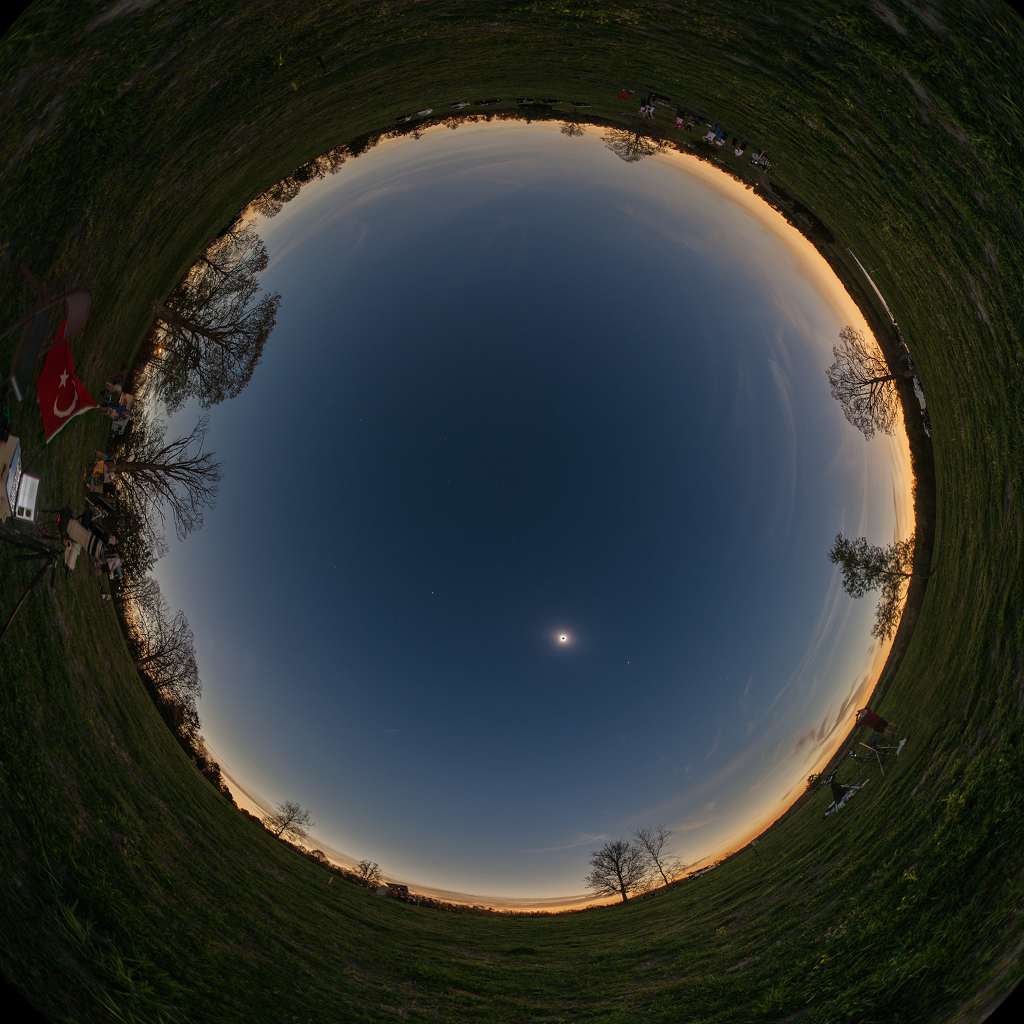
Image Credit & Copyright: Tunc Tezel (TWAN)
Explanation: If the Sun is up but the sky is dark and the horizon is bright all around, you might be standing in the Moon's shadow during a total eclipse of the Sun. In fact, the all-sky Moon shadow shown in this composited panoramic view was captured from a farm near Shirley, Arkansas, planet Earth. The exposures were made under clear skies during the April 8 total solar eclipse. For that location near the center line of the Moon's shadow track, totality lasted over 4 minutes. Along with the solar corona surrounding the silhouette of the Moon planets and stars were visible during the total eclipse phase. Easiest to see here are bright planets Venus and Jupiter, to the lower right and upper left of the eclipsed Sun.

Image Credit & Copyright: Markus Horn
Explanation: In northern hemisphere spring, bright star Regulus is easy to spot above the eastern horizon. The alpha star of the constellation Leo, Regulus is the spiky star centered in this telescopic field of view. A mere 79 light-years distant, Regulus is a hot, rapidly spinning star that is known to be part of a multiple star system. Not quite lost in the glare, the fuzzy patch just below Regulus is diffuse starlight from small galaxy Leo I. Leo I is a dwarf spheroidal galaxy, a member of the Local Group of galaxies dominated by our Milky Way Galaxy and the Andromeda Galaxy (M31). About 800 thousand light-years away, Leo I is thought to be the most distant of the known small satellite galaxies orbiting the Milky Way. But dwarf galaxy Leo I has shown evidence of a supermassive black hole at its center, comparable in mass to the black hole at the center of the Milky Way.
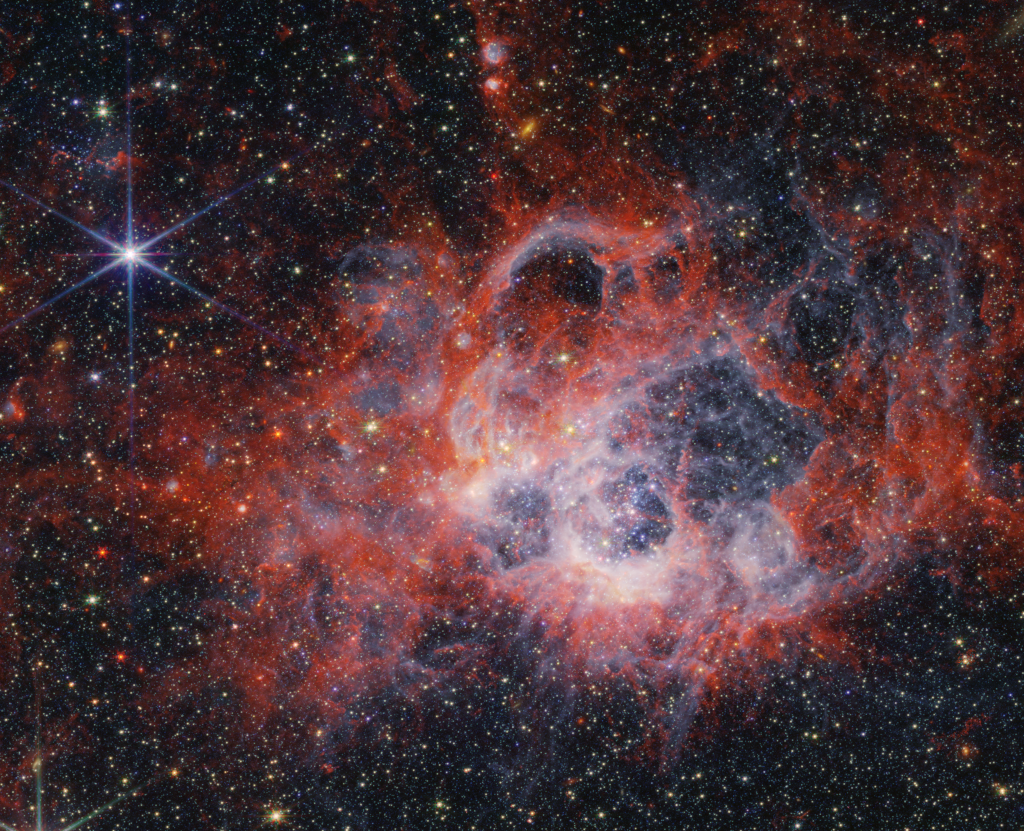
Image Credit: NASA, ESA, CSA, STScI
Explanation: Located some 3 million light-years away in the arms of nearby spiral galaxy M33, giant stellar nursery NGC 604 is about 1,300 light-years across. That's nearly 100 times the size of the Milky Way's Orion Nebula, the closest large star forming region to planet Earth. In fact, among the star forming regions within the Local Group of galaxies, NGC 604 is second in size only to 30 Doradus, also known as the Tarantula Nebula in the Large Magellanic Cloud. Cavernous bubbles and cavities in NGC 604 fill this stunning infrared image from the James Webb Space Telescope's NIRCam. They are carved out by energetic stellar winds from the region's more than 200 hot, massive, young stars, all still in early stages of their lives.

Image Credit & Copyright: Rowan Prangley
Explanation: How did a star form this beautiful nebula? In the middle of emission nebula NGC 6164 is an unusually massive star. The central star has been compared to an oyster's pearl and an egg protected by the mythical sky dragons of Ara. The star, visible in the center of the featured image and catalogued as HD 148937, is so hot that the ultraviolet light it emits heats up gas that surrounds it. That gas was likely thrown off from the star previously, possibly the result of a gravitational interaction with a looping stellar companion. Expelled material might have been channeled by the magnetic field of the massive star, in all creating the symmetric shape of the bipolar nebula. NGC 6164 spans about four light years and is located about 3,600 light years away toward the southern constellation Norma.

Image Credit & Copyright: Fatih Ekmen
Explanation: What created this giant X in the clouds? It was the shadow of contrails. When airplanes fly, humid engine exhaust may form water droplets that might freeze in Earth's cold upper atmosphere. These persistent streams of water and ice scatter light from the Sun above and so appear bright. These contrails cast long shadows. That was just the case over Istanbul, Türkiye, earlier this month. Contrails occur all over planet Earth and, generally, warm the Earth when the trap infrared light but cool the Earth when they efficiently reflect sunlight. The image was taken by a surprised photographer in the morning on the way to work.
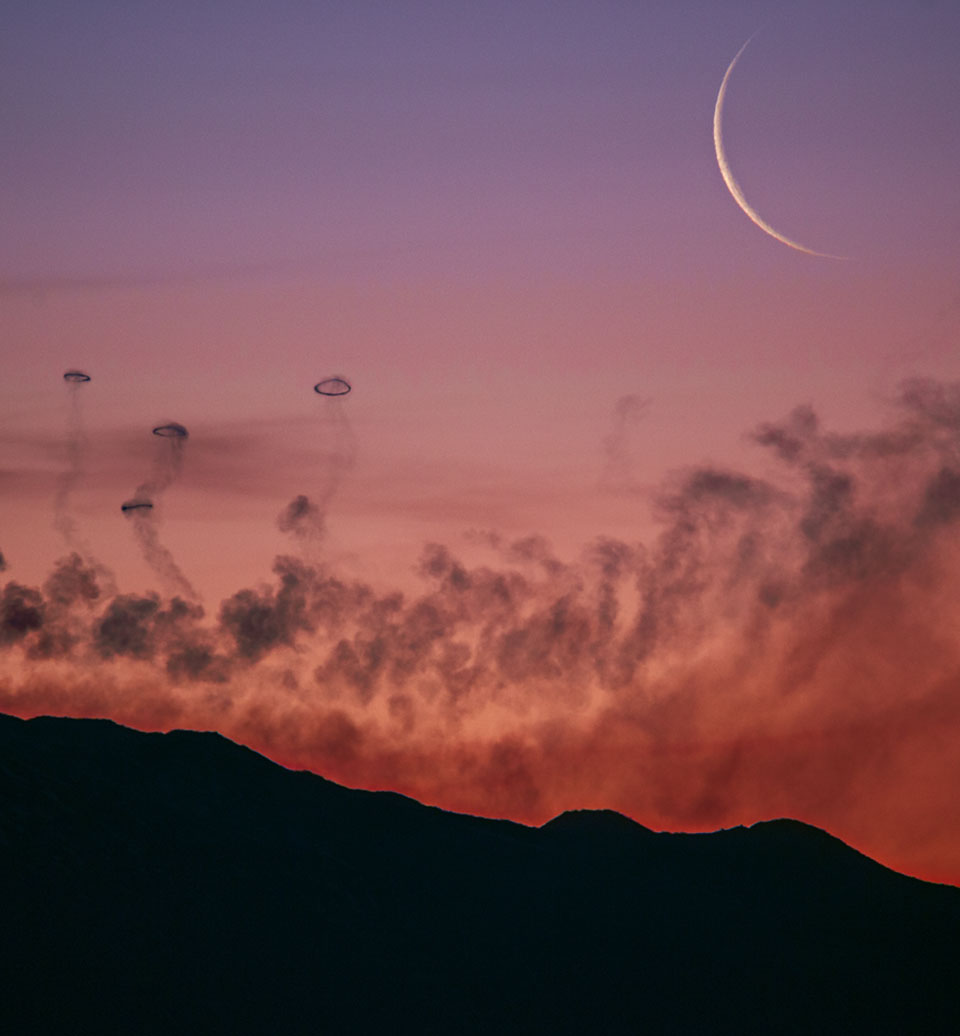
Image Credit & Copyright: Dario Giannobile
Explanation: Yes, but can your volcano do this? To the surprise of some, Mt. Etna emits, on occasion, smoke rings. Technically known as vortex rings, the walls of the volcano slightly slow the outside of emitted smoke puffs, causing the inside gas to move faster. A circle of low pressure develops so that the emitted puff of volcanic gas and ash loops around in a ring, a familiar geometric structure that can be surprisingly stable as it rises. Smoke rings are quite rare and need a coincidence of the right geometry of the vent, the right speed of ejected smoke, and the relative calmness of the outside atmosphere. In the featured image taken about two weeks ago from Gangi, Sicily, Italy, multiple volcanic smoke rings are visible. The scene is shaded by the red light of a dawn Sun, while a crescent Moon is visible in the background.
Video Credit & License: NASA, Juno, SwRI, MSSS, Gerald Eichstadt;
Music: The Planets, IV. Jupiter (Gustav Holst); USAF Heritage of America Band (via Wikipedia)
Explanation: Watch Juno zoom past Jupiter. NASA's robotic spacecraft Juno is continuing on its now month-long, highly-elongated orbits around our Solar System's largest planet. The featured video is from perijove 16, the sixteenth time that Juno passed near Jupiter since it arrived in mid-2016. Each perijove passes near a slightly different part of Jupiter's cloud tops. This color-enhanced video has been digitally composed from 21 JunoCam still images, resulting in a 125-fold time-lapse. The video begins with Jupiter rising as Juno approaches from the north. As Juno reaches its closest view -- from about 3,500 kilometers over Jupiter's cloud tops -- the spacecraft captures the great planet in tremendous detail. Juno passes light zones and dark belts of clouds that circle the planet, as well as numerous swirling circular storms, many of which are larger than hurricanes on Earth. As Juno moves away, the remarkable dolphin-shaped cloud is visible. After the perijove, Jupiter recedes into the distance, now displaying the unusual clouds that appear over Jupiter's south. To get desired science data, Juno swoops so close to Jupiter that its instruments are exposed to very high levels of radiation.

Image Credit & Copyright: Wright Dobbs
Explanation: When the dark shadow of the Moon raced across North America on April 8, sky watchers along the shadow's narrow central path were treated to a total solar eclipse. During the New Moon's shadow play diamonds glistened twice in the eclipse-darkened skies. The transient celestial jewels appeared immediately before and after the total eclipse phase. That's when the rays of a vanishing and then emerging sliver of solar disk are just visible behind the silhouetted Moon's edge, creating the appearance of a shiny diamond set in a dark ring. This dramatic timelapse composite from north-central Arkansas captures both diamond ring moments of this total solar eclipse. The diamond rings are separated by the ethereal beauty of the solar corona visible during totality.
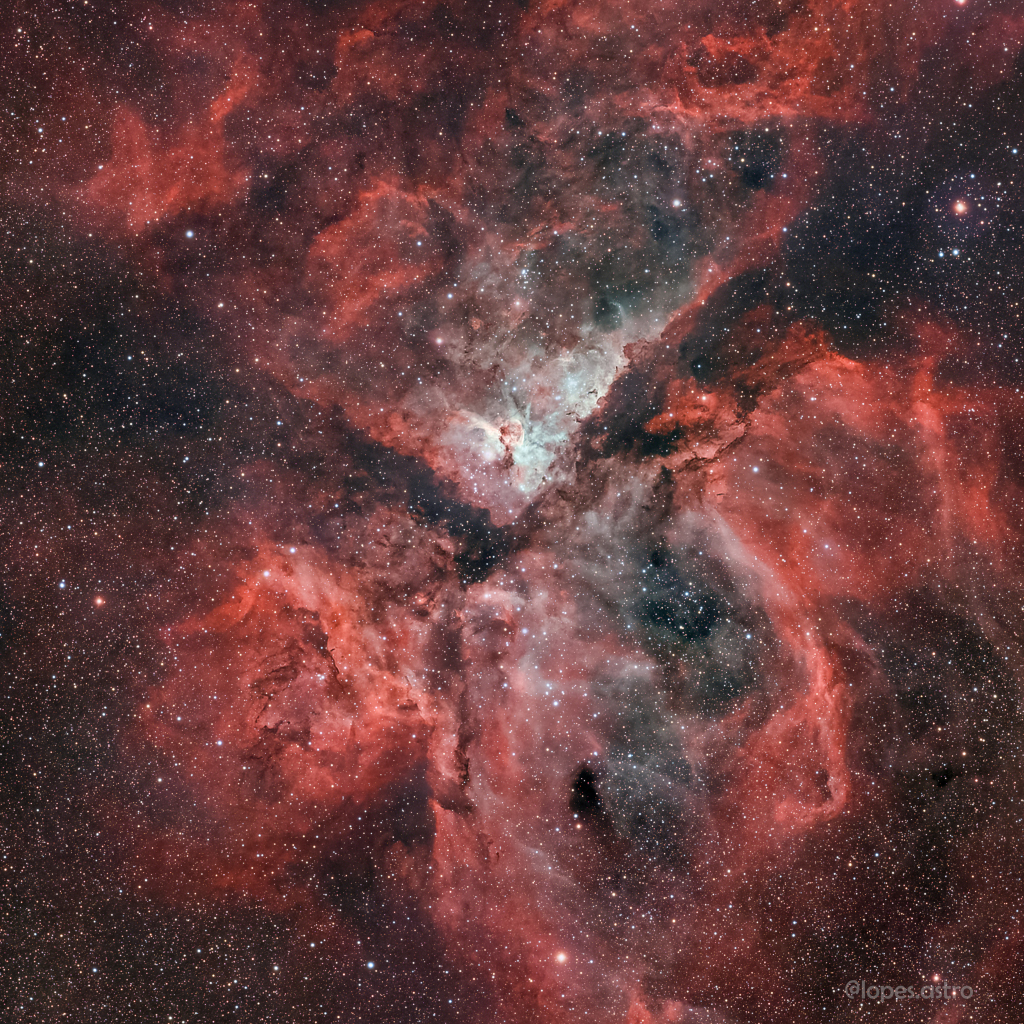
Image Credit & Copyright: Demison Lopes
Explanation: A jewel of the southern sky, the Great Carina Nebula is more modestly known as NGC 3372. One of our Galaxy's largest star forming regions, it spans over 300 light-years. Like the smaller, more northerly Great Orion Nebula, the Carina Nebula is easily visible to the unaided eye. But at a distance of 7,500 light-years it lies some 5 times farther away. This stunning telescopic view reveals remarkable details of the region's glowing filaments of interstellar gas and obscuring cosmic dust clouds. The Carina Nebula is home to young, extremely massive stars, including the still enigmatic variable Eta Carinae, a star with well over 100 times the mass of the Sun. Eta Carinae is the bright star above the central dark notch in this field and left of the dusty Keyhole Nebula (NGC 3324).
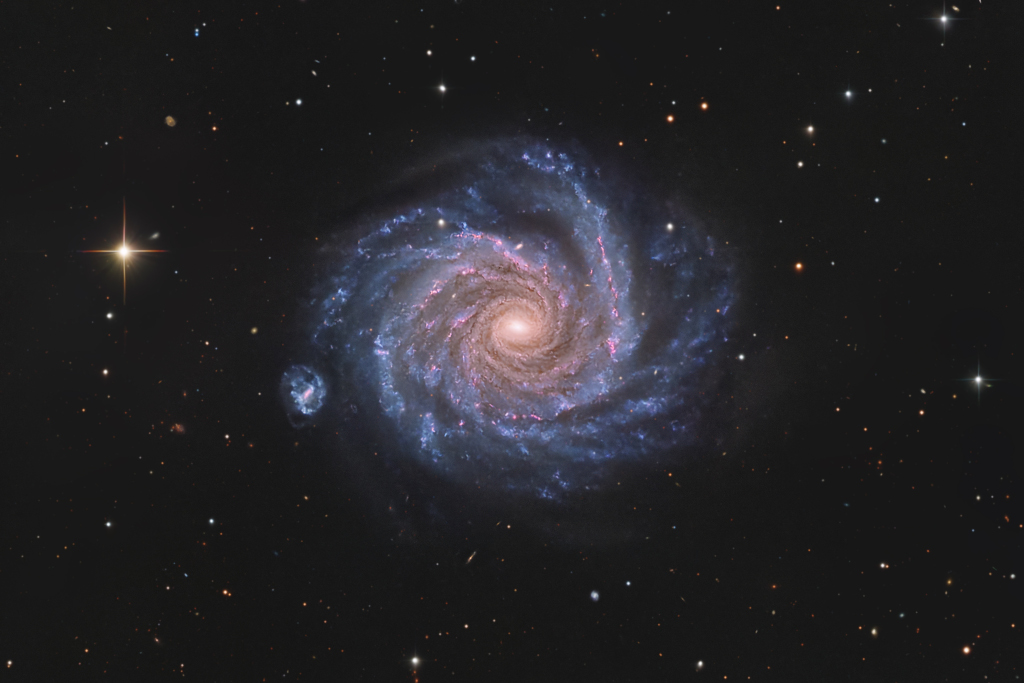
Image Credit & Copyright: Neil Corke
Explanation: From our vantage point in the Milky Way Galaxy, we see NGC 1232 face-on. Nearly 200,000 light-years across, the big, beautiful spiral galaxy is located some 47 million light-years away in the flowing southern constellation of Eridanus. This sharp, multi-color, telescopic image of NGC 1232 includes remarkable details of the distant island universe. From the core outward, the galaxy's colors change from the yellowish light of old stars in the center to young blue star clusters and reddish star forming regions along the grand, sweeping spiral arms. NGC 1232's apparent, small, barred-spiral companion galaxy is cataloged as NGC 1232A. Distance estimates place it much farther though, around 300 million light-years away, and unlikely to be interacting with NGC 1232. Of course, the prominent bright star with the spiky appearance is much closer than NGC 1232 and lies well within our own Milky Way.
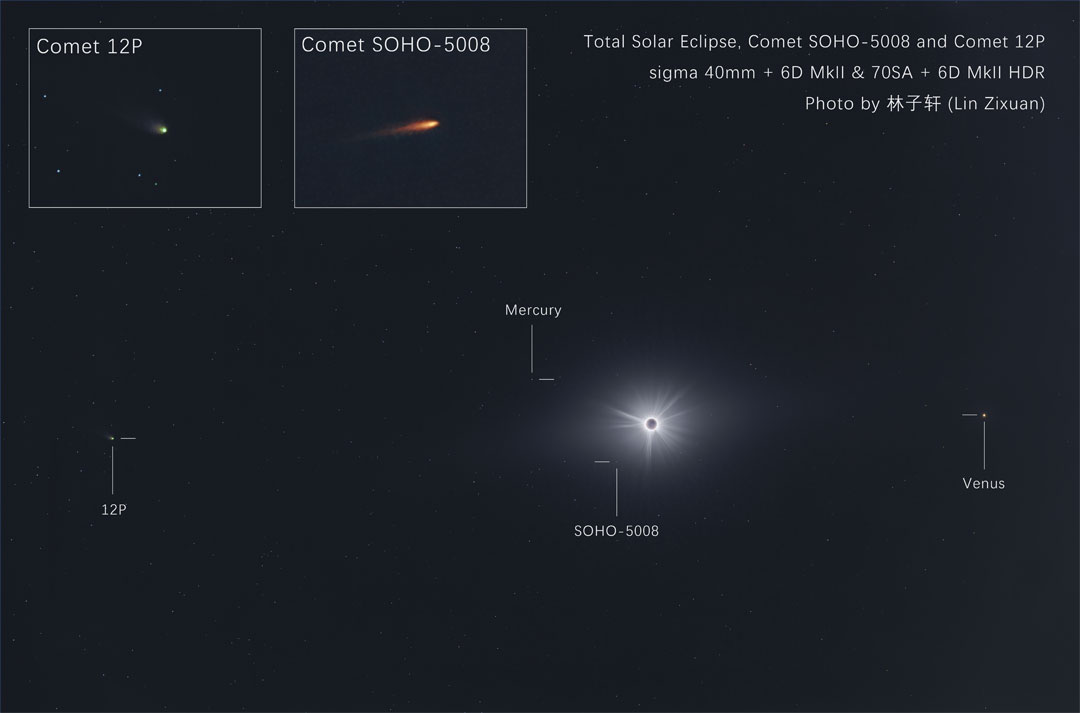
Image Credit & Copyright: Lin Zixuan (Tsinghua U.)
Explanation: Not one, but two comets appeared near the Sun during last week's total solar eclipse. The expected comet was Comet 12P/Pons-Brooks, but it was disappointingly dimmer than many had hoped. However, relatively unknown Comet SOHO-5008 also appeared in long duration camera exposures. This comet was the 5008th comet identified on images taken by ESA & NASA's Sun-orbiting SOHO spacecraft. Likely much smaller, Comet SOHO-5008 was a sungrazer which disintegrated within hours as it passed too near the Sun. The featured image is not only unusual for capturing two comets during an eclipse, but one of the rare times that a sungrazing comet has been photographed from the Earth's surface. Also visible in the image is the sprawling corona of our Sun and the planets Mercury (left) and Venus (right). Of these planets and comets, only Venus was easily visible to millions of people in the dark shadow of the Moon that crossed North America on April 8.
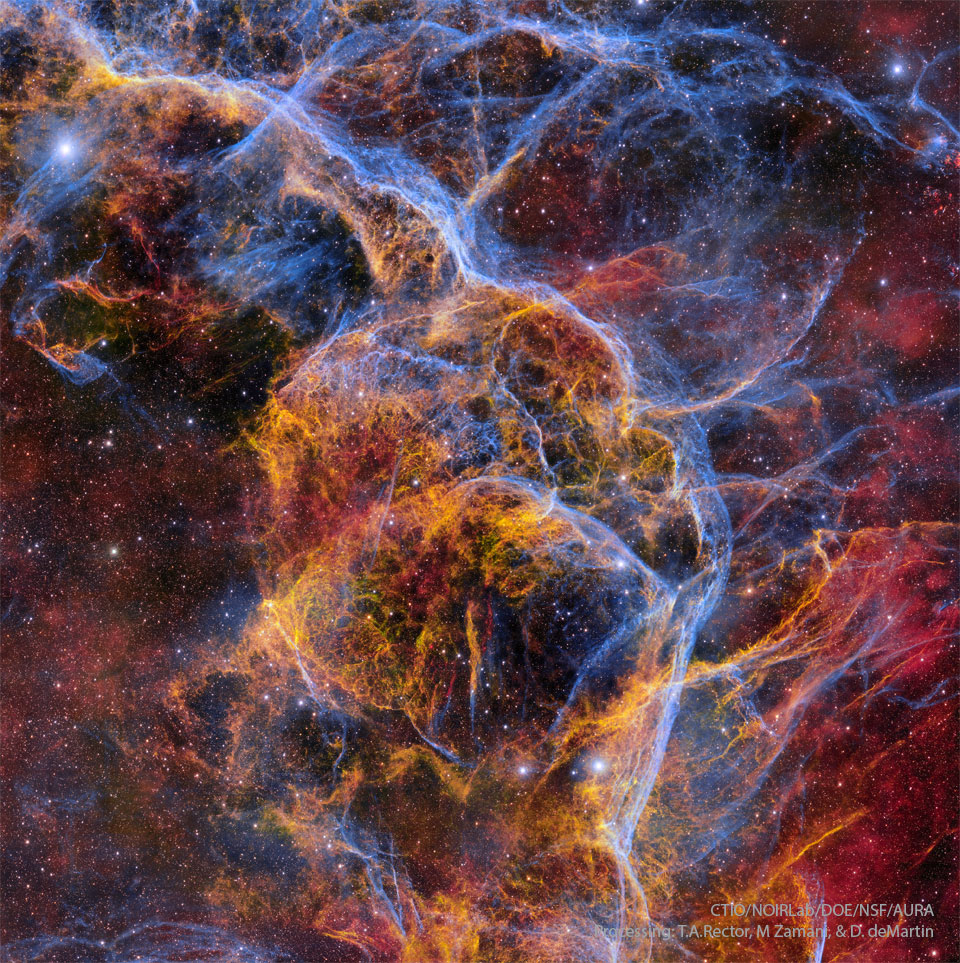
Image Credit: CTIO, NOIRLab, DOE, NSF, AURA; Processing: T. A. Rector (U. Alaska Anchorage), M. Zamani & D. de Martin (âs NOIRLab)
Explanation: The explosion is over, but the consequences continue. About eleven thousand years ago, a star in the constellation of Vela could be seen to explode, creating a strange point of light briefly visible to humans living near the beginning of recorded history. The outer layers of the star crashed into the interstellar medium, driving a shock wave that is still visible today. The featured image captures some of that filamentary and gigantic shock in visible light. As gas flies away from the detonated star, it decays and reacts with the interstellar medium, producing light in many different colors and energy bands. Remaining at the center of the Vela Supernova Remnant is a pulsar, a star as dense as nuclear matter that spins around more than ten times in a single second.
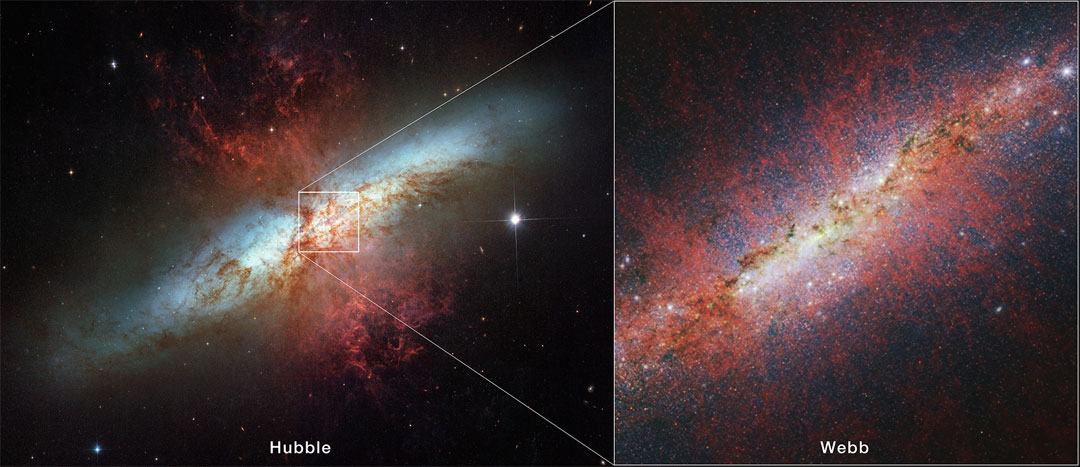
Image Credit: NASA, ESA, CSA, STScI, Alberto Bolatto (UMD)
Explanation: Something strange happened to this galaxy, but what? Known as the Cigar Galaxy and cataloged as M82, red glowing gas and dust are being cast out from the center. Although this starburst galaxy was surely stirred up by a recent pass near its neighbor, large spiral galaxy M81, this doesn't fully explain the source of the red-glowing outwardly expanding gas and dust. Evidence indicates that this material is being driven out by the combined emerging particle winds of many stars, together creating a galactic superwind. In the featured images, a Hubble Space Telescope image in visible light is shown on the left, while a James Webb Space Telescope image of the central region in infrared light is shown on the right. Detailed inspection of the new Webb image shows, unexpectedly, that this red-glowing dust is associated with hot plasma. Research into the nature of this strange nearby galaxy will surely continue.
Video Credit & Copyright: David Duarte
Explanation: How does a total solar eclipse end? Yes, the Moon moves out from fully blocking the Sun, but in the first few seconds of transition, interesting things appear. The first is called a diamond ring. Light might stream between mountains or through relative lowlands around the Moon's edge, as seen from your location, making this sudden first light, when combined with the corona that surrounds the Moon, look like a diamond ring. Within seconds other light streams appear that are called, collectively, Bailey's beads. In the featured video, it may seem that the pink triangular prominence on the Sun is somehow related to where the Sun begins to reappear, but it is not. Observers from other locations saw Bailey's beads emerge from different places around the Moon, away from the iconic triangular solar prominence visible to all. The video was captured with specialized equipment from New Boston, Texas, USA on April 8, 2024.
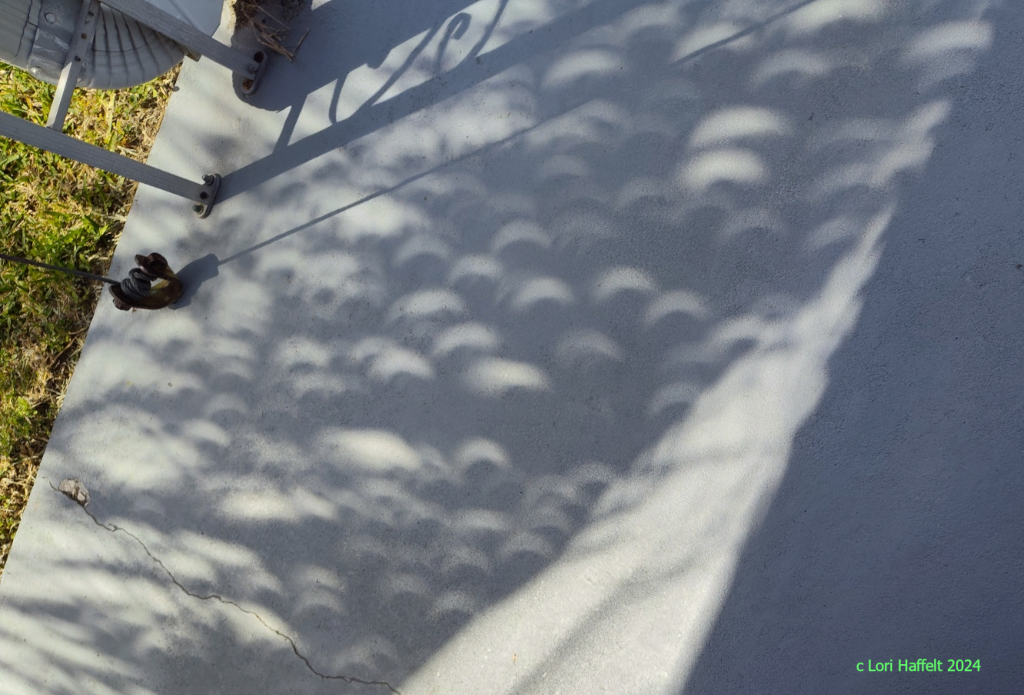
Image Credit & Copyright: Lori Haffelt
Explanation: Only those along the narrow track of the Moon's shadow on April 8 saw a total solar eclipse. But most of North America still saw a partial eclipse of the Sun. From Clearwater, Florida, USA this single snapshot captured multiple images of that more widely viewed celestial event without observing the Sun directly. In the shade of a palm tree, criss-crossing fronds are projecting recognizable eclipse images on the ground, pinhole camera style. In Clearwater the maximum eclipse phase was about 53 percent.
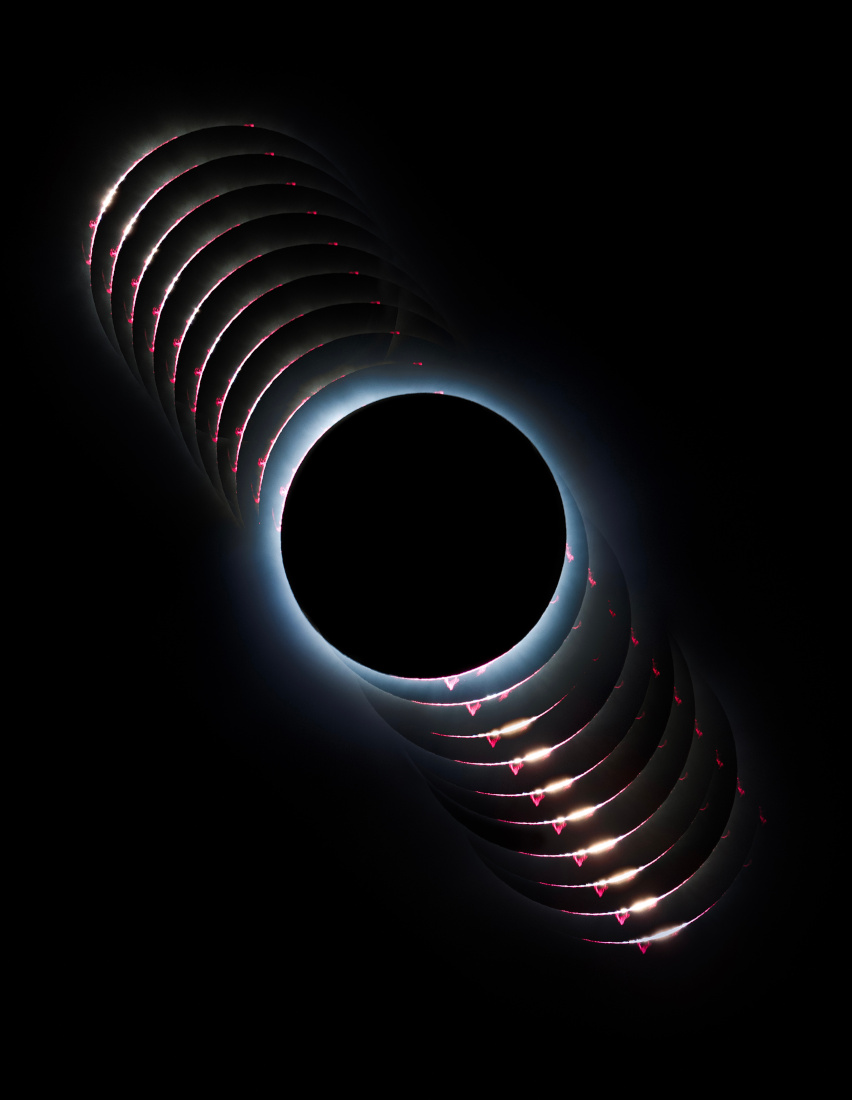
Image Credit & Copyright: Daniel Korona
Explanation: Baily's beads often appear at the boundaries of the total phase of an eclipse of the Sun. Pearls of sunlight still beaming through gaps in the rugged terrain along the lunar limb silhouette, their appearance is recorded in this dramatic timelapse composite. The series of images follows the Moon's edge from beginning through the end of totality during April 8's solar eclipse from Durango, Mexico. They also capture pinkish prominences of plasma arcing high above the edge of the active Sun. One of the first places in North America visited by the Moon's shadow on April 8, totality in Durango lasted about 3 minutes and 46 seconds.
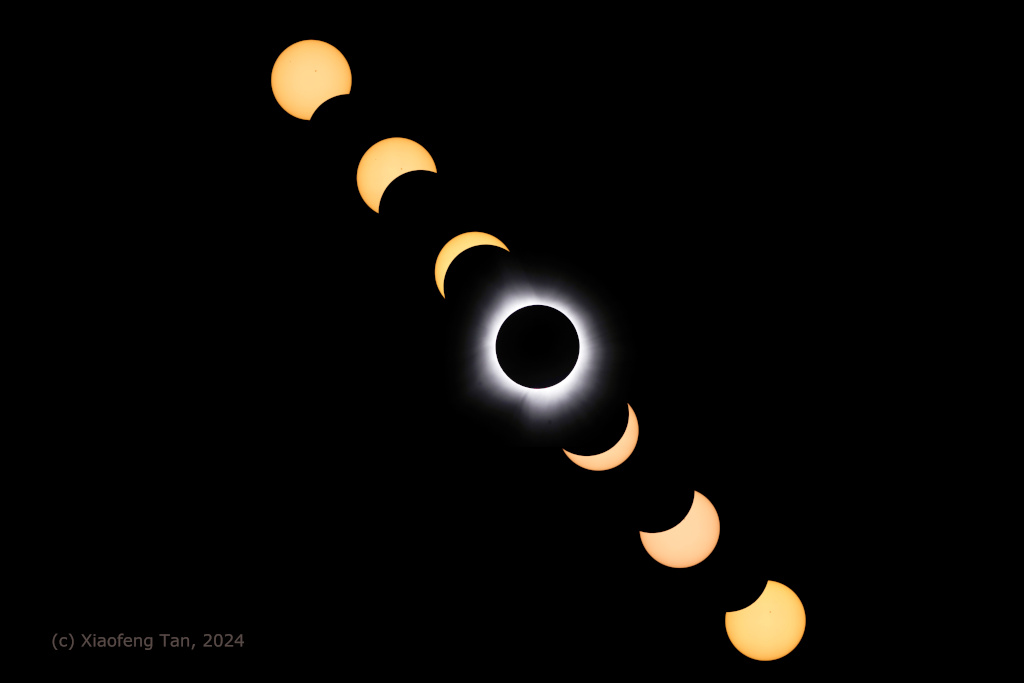
Image Credit & Copyright: Xiaofeng Tan
Explanation: Start at the upper left above and you can follow the progress of April 8's total eclipse of the Sun in seven sharp, separate exposures. The image sequence was recorded with a telescope and camera located within the narrow path of totality as the Moon's shadow swept across Newport, Vermont, USA. At center is a spectacular view of the solar corona. The tenuous outer atmosphere of the Sun is only easily visible to the eye in clear dark skies during the total eclipse phase. Seen from Newport, the total phase for this solar eclipse lasted about 3 minutes and 26 seconds.
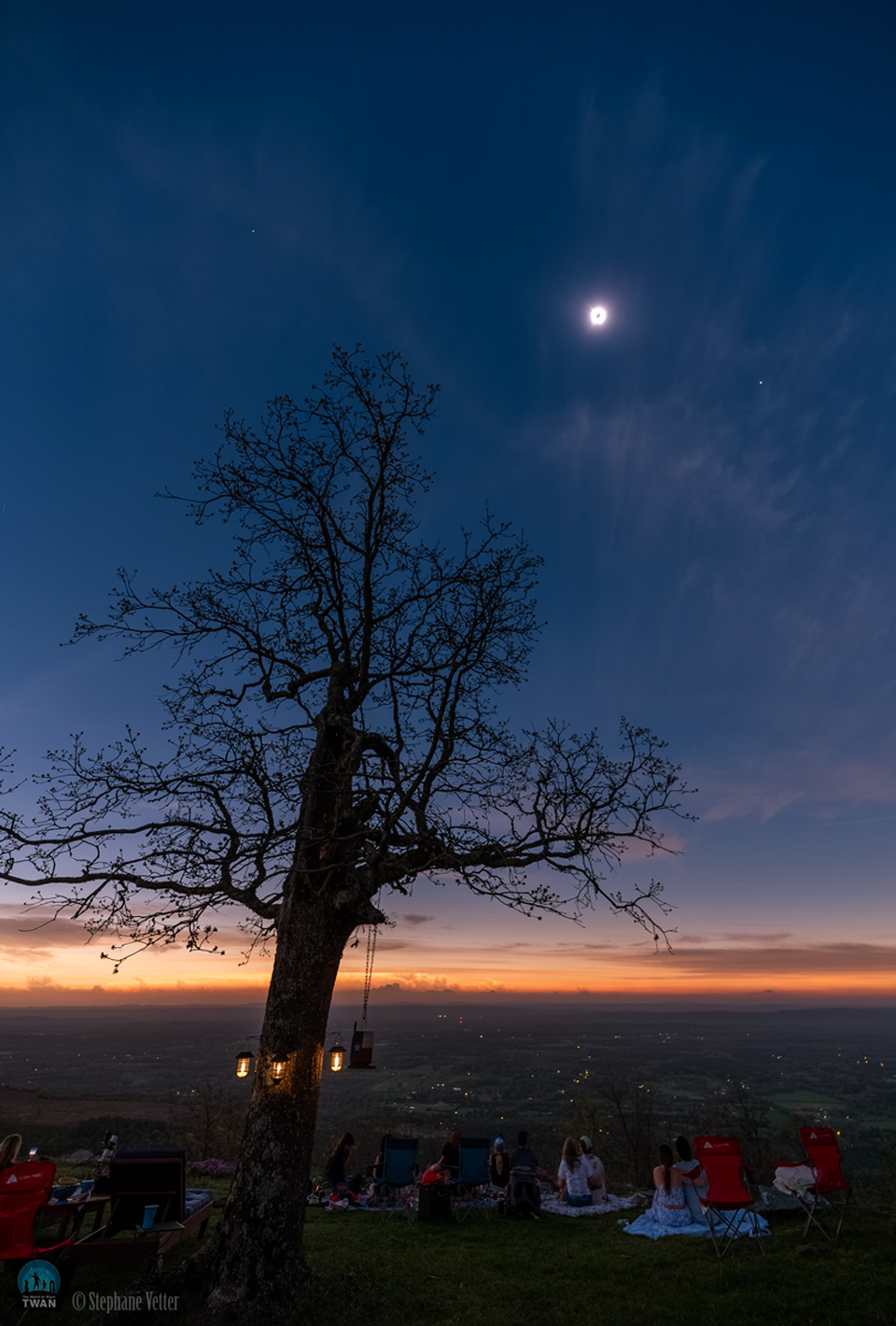
Image Credit: Stéphane Vetter (Nuits sacrées)
Explanation: What wonders appear when the Moon blocks the Sun? For many eager observers of Mondayâs total eclipse of the Sun, the suddenly dark sky included the expected corona and two (perhaps surprise) planets: Venus and Jupiter. Normally, in recent days, Venus is visible only in the morning when the Sun and Jupiter are below the horizon, while Jupiter appears bright only in the evening. On Monday, though, for well-placed observers, both planets became easily visible during the day right in line with the totally eclipsed Sun. This line was captured Monday afternoon in the featured image from Mount Nebo, Arkansas, USA, along with a line of curious observers â and a picturesque tree.

Image Credit & Copyright: Stan Honda
Explanation: Captured in this snapshot, the shadow of the Moon came to Lake Magog, Quebec, North America, planet Earth on April 8. For the lakeside eclipse chasers, the much anticipated total solar eclipse was a spectacle to behold in briefly dark, but clear skies. Of course Lake Magog was one of the last places to be visited by the Moon's shadow. The narrow path of totality for the 2024 total solar eclipse swept from Mexico's Pacific Coast north and eastward through the US and Canada. But a partial eclipse was visible across most of the North American continent.